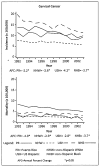Burden of human papillomavirus infection and related comorbidities in men: implications for research, disease prevention and health promotion among Hispanic men
- PMID: 20799510
- PMCID: PMC3038604
Burden of human papillomavirus infection and related comorbidities in men: implications for research, disease prevention and health promotion among Hispanic men
Abstract
Genital human papillomavirus (HPV) infection is one of the most commonly diagnosed sexually transmitted infections world-wide. Over the last two decades, research has established a strong causal link between specific types of HPV infection and cancer, particularly cervical, anal, vulvar/vaginal, penile, and oropharyngeal cancer. Limited epidemiological studies of anogenital HPV infection have been conducted in Hispanic populations (including Puerto Rico), and population-based incidence and prevalence estimates of HPV infection among Hispanics are limited. Studies that evaluate knowledge and awareness of HPV among men are also scarce. With the world-wide introduction of two new prophylactic vaccines against high-risk HPVs causing cervical cancer, and the recent FDA approval of the quadrivalent vaccine in preventing genital warts in men, there is an urgency to determine the burden of HPV in Hispanic populations before vaccine programs are implemented on a widespread basis. Knowledge and acceptability of the vaccine prior to implementation of these programs are also necessary to allow a targeted assessment. This review article summarizes existing research on HPV infection and HPV-related morbidities in men, with a particular emphasis on Hispanic men in the United States and Puerto Rico. Three major areas are discussed: (1) genital warts, (2) HPV and related cancers and (3) biobehavioral and psychosocial factors related to HPV infection and vaccination. Specific recommendations for advancing HPV research and knowledge among Hispanic populations also are suggested.
Figures


References
-
- Pagano JS, Blaser M, Buendia MA, Damania B, et al. Infectious agents and cancer: Criteria for a causal relation. Semin Cancer Biol. 2004;14:453–471. - PubMed
-
- Pagliusi S. Vaccines against Human Papillomavirus. World Health Organization; Retrieved January 25, 2009 from the World Wide Web: http://www.who.int/vaccines/en/hpvrd.shtml.
-
- Steben M, Duarte-Franco E. Human papillomavirus infection: Epidemiology and pathophysiology. Gynecol Oncol. 2007;107:S2–S5. - PubMed
-
- Weinstock H, Berman S, Cates W. Sexually transmitted diseases among American youth: Incidence and prevalence estimates, 2000. Perspect Sex Reprod Health. 2004;36:6–10. - PubMed
-
- Gerberding JL. Center for Disease Control and Prevention; 2004. Report to Congress: Prevention of Genital Human Papillomavirus Infection: Centers for Disease Control and Prevention. Retrieved November 11, 2008 from the World Wide Web: http://www.cdc.gov/std/HPV/2004HPV%20report.pdf.
Publication types
MeSH terms
Grants and funding
LinkOut - more resources
Full Text Sources
